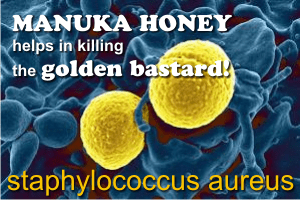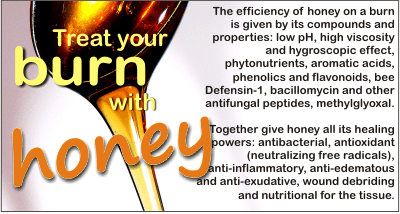The antibacterial effect of manuka on wounds has been long recognized. In 2004 Britain’s National Health Service has licensed the use of manuka-honey wound dressings and sterilized medical grade manuka-honey creams. There are lots and lots of scientific studies, lab tests, clinical trials. There is no doubt that manuka honey is one of the best natural treatment (better than synthetic drugs) for skin infections.
Egyptians and Greeks used honey for wound care, and a broad spectrum of wounds are treated all over the world with natural unprocessed honeys from different sources. In Victoria, Australia, it is used extensively on cattle, sheep and horse stations (ranches).
When compared with other varieties of honey in scientific studies, Manuka honey has the highest and broadest antibacterial activity.
Manuka honey is used to treat many types of wound, including:
traumatic wounds, surgical incision sites, burns, sloughy wounds, and pressure ulcers.
When talking about manuka honey used in skin infections, we are actually talking about medical grade honey. In Dictionary/thesaurus we found the following explanation for manuka honey: “A medicinal grade honey applied topically to treat decubitus ulcers or prepare wound beds for skin grafts application.
When compared to standard hydrogel therapy, venous leg ulcers dressed with manuka honey have less slough, better healing and a lower incidence of infection.” (No, they don’t mention using it internally)
What’s the difference between manuka honey and medical grade honey?
Although it is made from manuka honey, the medical grade honey has to conform to rigorous standards of quality and consistency. It is tested for microbiological contamination and assayed for water content and phytochemical composition. It is filtered and blended into a master batch with the purity and consistency to qualify for use in a moist wound environment. After that it is gamma irradiated, in order to destroy any residual microbial spores.
Can we use manuka honey bought from the supermarket for our wounds?
Ken Allen, managing director of a firm which makes wound dressings impregnated with manuka honey for the NHS, says: ‘We use the same honey you get in the supermarket, but we then sterilize and purify it because we are held to much stricter standards.’

It seems it is alright to use manuka honey at home, on minor burns and cuts, but not for the large and deep ones. In non-medical grade honey, meaning in the regular honey, there have been found traces of paint and lead, when examined under the microscope. We better choose a medical grade one to be sure.
As for the grade that are recommended for wounds and burns, Ken Allen says we don’t need to worry about how potent the honey is: ‘It doesn’t have to have a high rating. Even one as low as UMF 10 can heal leg ulcers.’ So, if you want only a gentle antiseptic, the lower rating of either UMF or MGO should do the trick. Manuka with a UMF rating that’s too high (19 or over) can cause burning or stinging. The most therapeutic range appears to be between 16-18. You can use this UMF amount safely.
There really is no need in buying one with the highest MGO or UMF.
Remember to read the labels properly and choose the best you need.
Table Grade: 100 – 400 MGO (10 – 20 UMF) – this is for eating!
Antibacterial Grade: 400 – 850 MGO (20 – 35 UMF) – this is for skin therapy!
Superior Antibacterial Grade: 850 MGO and above (35 UMF and above) – this is for very bad wounds. (but are very hard to find on the market)
and read more on Manuka honey here.
How does it work?
Dr. Sanjay Gupta says in a CNN show: “We don’t quite know how these manuka honeys prevent and kill infections, but a compound in them called methylglyoxal seems to interact with a number of other unknown compounds in honey to prevent infectious bacteria developing new strains that are resistant to it.
Other scientists say that:
“Manuka honey has antimicrobial activity, deodorising action, debriding action and osmotic effect, anti-inflammatory activity, antioxidant activity, and enhanced rate of healing. Essentially, honey can be regarded as an antimicrobial agent with the ability to promote wound healing.”
Honey works differently from antibiotics, which attack the bacteria’s cell wall or inhibit intracellular metabolic pathways. To quote specialists, manuka honey “stimulates the rate of angiogenesis, granulation and epithelialization, and speeds up the healing process”, probably due to the following factors:
Hygroscopic activity:
Honey is hygroscopic, meaning it has a low water content and draws moisture out of the environment, thus dehydrating any bacteria.
Sugar content:
– Its sugar content is also high enough to hinder the growth of microbes, but the sugar content alone is not the sole reason for honey’s antibacterial properties. (When honey is diluted with water, reducing its high sugar content, it still inhibits the growth of many different bacterial species that cause wound infections). (Sugars in honey)
– Also, due to its high sugar content, honey also prevents pain on dressing changes as it keeps the wound surface moist by mobilizing the oedema from the surrounding tissues.
Other substances:
Over 100 substances are candidates for the particular antibacterial property of manuka honey, but the active ingredient has not yet been identified. Even if the hydrogen peroxide activity is blocked and the osmotic effect of honey is circumvented by dilution, selected honeys from Leptospermum species, still have significant antibacterial effects.
Low pH level:
Bacterial colonization or infection and recalcitrant wound healing situations are often accompanied by pH values >7.3 in wound exudates. It has been demonstrated that acidification of wounds speeds healing, because a lowe pH increases the amount of oxygen off-loaded from hemoglobin in the capillaries.
More recently it has also been attributed to suppression of protease activity in wounds by getting away from the neutral pH that is the optimum for their activity. Excessive protease activity in a wound can slow or prevent healing by destroying growth factors (which are proteins) and destroying the protein fibres and fibronectin in the wound matrix, attachment to which activates fibroblasts and is necessary for the migration of these and of epithelial cells (according to worldwidewounds.com). This protease activity results from excessive inflammation. The anti-inflammatory activity of honey would thus remove this impediment to healing, as would the antibacterial activity working through removing infecting bacteria stimulating the inflammatory response.
MGO vs hydrogen peroxide activity:
Manuka honey contains methylglyoxal (MGO), which is a toxic  substance, related to the development or worsening of many degenerative diseases, including Alzheimer’s disease, cardiovascular disease, stroke, eye cataracts, cancer and diabetes. Manuka contains a very high level og MGO, over 1,000 ppm. Which is why, therapists are cautious in recommending it internally. Yet, Carter and colleagues say that while MGO binds to protein and DNA, and is very toxic to human cells when it is on its own, when it is contained in honey, it will not damage human cells, but still kill bacterial cells. On toppical wounds, the product is completely safe, a reason for its notoriety. (Read more if it is safe to eat manuka honey.)
substance, related to the development or worsening of many degenerative diseases, including Alzheimer’s disease, cardiovascular disease, stroke, eye cataracts, cancer and diabetes. Manuka contains a very high level og MGO, over 1,000 ppm. Which is why, therapists are cautious in recommending it internally. Yet, Carter and colleagues say that while MGO binds to protein and DNA, and is very toxic to human cells when it is on its own, when it is contained in honey, it will not damage human cells, but still kill bacterial cells. On toppical wounds, the product is completely safe, a reason for its notoriety. (Read more if it is safe to eat manuka honey.)
The hydrogen peroxide activity is common to all honeys and is triggered by an enzyme found in honey, glocose oxidase. It’s an enzyme added by the bees into honey, which will break the glucose down into gluconic acid and hydrogen peroxide. Hydrogen peroxide (H2O2) is a disinfectant used in our medicinal world, from the beginnings. In honey this substances is stable and released little by little, a fact that makes it superior to being simply applied on the wound, on its own. Read more about the antibacterial properties of honey.
Anti-inflamatory activity:
The amount of wound exudate is related to the activity of the local inflammatory process, especially in wounds, which can get infected with bacteria. The anti-inflammatory action of honey reduces oedema and the amount of exudate by down regulating the inflammatory process. It also reduces pain, as the pain in wounds results from the nerve endings being sensitized by prostaglandins produced in the process of inflammation, as well from the pressure on tissues resulting from oedema.
The anti-inflamatory effect was observed in many animal trials, as they cannot demonstrate any placebo effects. An animal cannot influence the healing process as it cannot believe a product is better than another.
Speeds the healing process:
Here are some possible explanations.
“It stimulates an inflammatory response in leukocytes, as inflammation is what triggers the cascade of cellular events that give rise to the production of growth factors which control angiogenesis and proliferation of fibroblasts and epithelial cells. Very recently, Tonks et al. discovered a 5.8 kDA component of manuka honey which stimulates the production of TNF-α in macrophages via Toll-like receptor 4.”
No “dead rabbit” odor of the wound:
A compared to the other products, medical manuka honey manages the problem of malodour from chronic colonized wounds, which results in severe discomfort and social isolation of these patients.
Here is case of a female with relapsed breast cancer after chemotherapy and irradiation. Nobody could even enter her room because her wound smelled like a ‘dead rabbit’. This malodour problem was successfully eliminated with the application of medical honey in 2 weeks.
Medical grade honey is not considered an antiseptic
Why?
Because an ideal wound antiseptic must have a fast onset of bactericidal action and a remnant, broad spectrum effect against bacteria and fungi, even under the unfavorable conditions of exudating, colonized or infected wounds. And an enhancement and acceleration of the physiologic process of wound healing (debridement, granulation), even if applied for prolonged periods.
This honey doesn’t have ‘a fast onset of activity’, as it does not seem to produce the desired reduction of bacteria (more than five log steps) and fungi in 1–10 min to be qualified as an antiseptic.
What are the most popular medical grade honeys?
Since 1999, products containing medical grade honey have been licensed for wound care and now they are widely
used. Here are some of them:
Berringa antibacterial honey produced by Australian Organic Honey Company.
Medihoney™ honey wound dressings, produced by Derma Sciences, Inc., Toronto, Canada. The product contains sterilized manuka honey. After applying the gel/paste it is recommended to use an absorbent dressing like Xtrasorb®, produced in 3 forms according to the wound, by Derma Sciences.
Revamil® produced by Bfactory Health Products BV, but NOT from manuka honey.
Medical Grade Manuka Honey produced by Manukaguard, from manuka honey.
Activon medical grade honey for wounds, produced by Advancis Medical, New Zealand. From manuka honey.
LifeMel honey – one amazing medical grade honey, made not from manuka honey, but from special herbs meant to support the honey’s purpose: to prevent and treat the side effects of radiation and chemotherapy, suffered by cancer patients. Not for wounds.
Studies
• In immunocompromized patients the frequency of chemo and radiations results in wound healing problems and can cause secondary potentially life-threatening bloodstream infections.
In the presented case a 12-year old patient has an abdominal lymphomaremoved and was left with an open drainage site on his abdomen. His wound infected with methicillin-resistant Staphylococcus aureus (MRSA). the patient was immediately isolated, and treated with a local antiseptic (octenidin) for 12 days.
But no improvement occurred, a situation that forced the doctors totry something else, and decided to use the Australian medical honey (Medihoney™). The wound was free of bacteria two days later. (Medical Honey for Wound Care—Still the ‘Latest Resort’? – source page link).
• In Maharashtra India, a study has been made on 104 patiens with first-degree burns.
· After 7 days 91 percent of honey-treated burns were infection-free, compared with 7 percent of those treated with silver sulfadiazine, the conventional burns treatment.
· After 15 days, 87 percent of honey-treated burns were healed, compared with 10 percent of the silver sulfadiazine-treated burns.
• In one study, an immune-suppressed patient had a leg ulcer containing the deadly antibiotic-resistant MRSA (methicillin-resistant Staph. aureus) bacteria. Topical and systemic antibiotics were not enough to get the infection under control. The ulcer was simply not healing. As soon as it was treated with a topical dressing of Manuka honey, the ulcer healed.
• In another study, doctors used Manuka honey to dress leg ulcers once a week for four weeks in eight patients. There was a 50% improvement in the ulcers. It also eliminated all odors (a sign of bacterial overgrowth). And it reduced pain in all the participants.
• Many of the 150 wound care patients treated with medical honey had previously received specialist attention for recalcitrant wounds. When treatment with honey was commenced, their wound status changed to healing from non-healing.
• A burn patient was treated with a silver-coated dressing, but this caused raised liver enzymes and an argyria-like syndrome.
Another common treatment is povidone iodine, which has the advantage of antiseptic properties and is well suited for skin disinfection prior to invasive procedures. However, the antiseptic activity of iodine products is hampered by interactions with the protein content of the wound exudate and severe adverse effects of systemic absorption of iodine on thyroid function must be considered in infants and toddlers as well as in adult patients with latent hyperthyreosis.
Alcohol-containing antiseptics, are almost completely absorbed and need to be metabolized by the children, who are treated concomitantly with many other drugs.
In contrast, medical honey does not display the problem of systemic absorption and thus can even be utilized in patients with diabetes mellitus without adverse effects on blood glucose levels.
• A review of 19 randomised controlled trials (RCTs) with a total of 2554 participants suggested that honey improved healing times in mild to moderate superficial and partial thickness burns when compared to conventional dressings (Jull et al, 2008).
Recommended books:
Dr Rose Cooper of the University of Wales Cardiff School of Health Sciences has researched honey’s antibacterial action and has written the book Honey: A Modern Wound Management Product with Peter Molan and Richard White.
It was published in 2005, it has 228 pages on paperback and it’s only $19.29. Unfortunately, you won’t find any new copies, but the used ones available for selling are in verry good condition. Definitely worth buying.
****************
References:
http://www.ncbi.nlm.nih.gov/pmc/articles/PMC2686636/#B23
http://www.dailymail.co.uk/health/article-1134423/Is-manuka-honey-really-worth-money.html
“Plaster On Forefinger” picture credit Ambro via FreeDigitalPhotos.net



